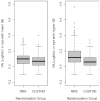A randomized, clinical trial evaluating ready-made and custom spectacles delivered via a school-based screening program in China
- PMID: 19592103
- PMCID: PMC4252048
- DOI: 10.1016/j.ophtha.2009.04.004
A randomized, clinical trial evaluating ready-made and custom spectacles delivered via a school-based screening program in China
Abstract
Purpose: We sought to evaluate visual performance and satisfaction with ready-made spectacles (RMS) in Chinese school-aged children with uncorrected refractive error.
Design: Randomized, double-blind, clinical trial.
Participants: Junior high school students from urban Guangzhou, China, aged approximately 12 to 15 years with > or =1 diopter (D) of uncorrected spherical equivalent (SE) refractive error. Students were excluded with > or =2.00 D astigmatism, > or =2 D myopic anisometropia, and > or =1 D hyperopic anisometropia and ocular disease affecting vision.
Methods: Refractive error was determined by cycloplegic subjective refraction. Students were randomly assigned to receive RMS or custom spectacles (CS) and assessed after 1 month of use. We required 175 students to complete in each arm to be able to measure a 15% difference in compliance.
Main outcome measures: Compliance with spectacles lens wear, patterns of use, vision, symptoms, and perceived value.
Results: Screening identified 965 of 4607 (20.9%) students with reduced distance vision; 212 of the 965 (22.0%) refused evaluation and 187 of the 965 (20.8%) had <1 D of SE refractive error. Sixty-one (6.3%) were referred for further evaluation and the remaining 495 (51.3%) participated. Social, demographic, and ocular parameters were similar in the 2 groups. Average SE refractive error was -2.57+/-1.31 (mean value +/- standard deviation [SD]). Spectacle vision (Snellen acuity, mean +/- SD) was worse with RMS in the eye with lower SE (20/25(-0.5)+/-0.9 lines vs 20/25(+1)+/-0.7 lines; P = 0.004) and higher SE (20/25(-2)+/-1.2 lines vs 20/25(+1)+/-0.8; P<0.001). There were no differences (P>0.05) in the rate of use (94.3% vs 92.2%), wearing to the 1-month visit (46.9% vs 51.5%), planned use (93.3% vs 93.7%), value (89.5% vs 91.7% "moderate or high value or most valued possession"), or symptoms (blur, 21.1% vs 19.4% [P = 0.8] and other symptoms [P>0.2]).
Conclusions: Although visual acuity was better with CS, no difference was found in acceptability in this population of students with predominantly simple myopic refractive error. This study supports the use of RMS in a school-based refractive services program, saving costs and improving the logistics of service delivery.
Figures


References
-
- He M, Zeng J, Liu Y, et al. Refractive error and visual impairment in urban children in southern China. Invest Ophthalmol Vis Sci. 2004;45:793–9. - PubMed
-
- Gilbert C, Foster A. Childhood blindness in the context of VISION 2020 —the Right to Sight. [Accessed March 28, 2009];Bull World Health Organ. 2001 79:227–32. Available at: http://www.scielosp.org/pdf/bwho/v79n3/v79n3a11.pdf. - PMC - PubMed
-
- Castanon Holguin AM, Congdon N, Patel N, et al. Factors associated with spectacle-wear compliance in school-aged Mexican children. Invest Ophthalmol Vis Sci. 2006;47:925–8. - PubMed
-
- Congdon N, Patel N, Esteso P, et al. The association between refractive cutoffs for spectacle provision and visual improvement among school-aged children in South Africa. Br J Ophthalmol. 2008;92:13–8. - PubMed
Publication types
MeSH terms
Grants and funding
LinkOut - more resources
Full Text Sources
Medical

